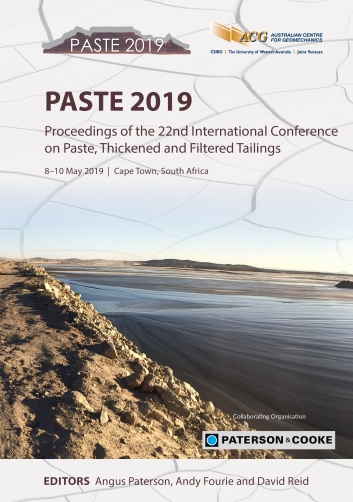Dareh Alou thickened tailings management scheme: design considerations

|
Authors: Roshdieh, A; Seddon, K; Mohebbi, M; Shakeri, K; Nosrati, M |
DOI https://doi.org/10.36487/ACG_rep/1910_03_Roshdieh
Cite As:
Roshdieh, A, Seddon, K, Mohebbi, M, Shakeri, K & Nosrati, M 2019, 'Dareh Alou thickened tailings management scheme: design considerations', in AJC Paterson, AB Fourie & D Reid (eds), Paste 2019: Proceedings of the 22nd International Conference on Paste, Thickened and Filtered Tailings, Australian Centre for Geomechanics, Perth, pp. 89-100, https://doi.org/10.36487/ACG_rep/1910_03_Roshdieh
Abstract:
This paper presents a case study on the design of a thickened tailings storage facility (TSF) for a proposed open pit copper mine at Dareh Alou, Iran. Dareh Alou mine is a new copper mine owned by National Iranian Copper Company (NICICO). It is located in the Kerman Province of the Islamic Republic of Iran. The nominal production rate is 7 Mtpa for a life-of-mine (LOM) of 25 years. Planning was undertaken for the accommodation of a total of 175 Mt of tailings. The Dareh Alou mine site is located on a sloping side of a valley that is surrounded by hills, grading up to steep mountainous terrain. Since this is a greenfield project the location of the concentrator was selected in conjunction with the tailings deposition options study. Five concentrator locations with various ore transportation options have been investigated together with the tailings and water management study. The result of the study indicated that the best concentrator plant location was at RL 3050 m at approximately 2.5 km from the preferred TSF location. Various tailings and water management options were evaluated, including high rate, high density/high compression, and paste thickeners. These dewatering options were studied alongside the combinations of various TSF and thickener locations. The outcome of the options study indicates that if the price of make-up water is not included in the analyses, the preferred option is utilisation of high rate thickeners. However, after inclusion of make-up water at a rate of USD 1/m3, the preferred option would be the utilisation of high density/high compression thickeners. In this case, the distance between the concentrator and the TSF is such that transportation of un-thickened tailings to thickeners located adjacent to the TSF is the most efficient option. Also, thickening the tailings will provide benefits in reducing the embankment construction cost even though relatively large embankments will be required to close off the valley site.
Keywords: copper mine, thickened tailings, water saving, trade-off study
References:
Fitton, TG & Roshdieh, A 2012, The Impact of Slurry Rheology on Tailings Transport and Disposal Options – Four Cases Studies, presented at the IIR’s 2nd Slurry Pipelines Conference, 20–21 November 2012, Perth, Australia.
Seif, HR, Roshdieh, A & Zaker, H 2014, ‘Optimisation of tailings and water management schemes in Taft and Dareh Alou copper mines’, Proceedings of the International Symposium on Dams in a Global Environmental Challenges, International Commission on Large Dams, Paris.
© Copyright 2025, Australian Centre for Geomechanics (ACG), The University of Western Australia. All rights reserved.
View copyright/legal information
Please direct any queries or error reports to repository-acg@uwa.edu.au
View copyright/legal information
Please direct any queries or error reports to repository-acg@uwa.edu.au


